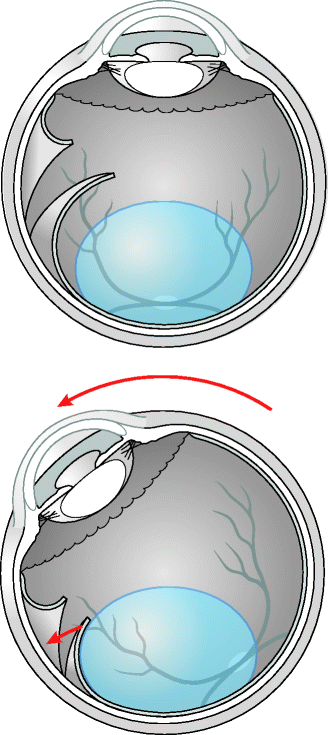(1)
Department of Ophthalmology, St. Thomas’ Hospital, London, UK
7.3 Pseudophakic RRD
7.4 Aphakic RRD
7.5 Retinal Dialysis
7.5.1 Clinical Features
7.5.3 Complications
7.5.4 Giant Retinal Dialysis
7.5.5 Dialysis and PVR
7.5.6 Par Ciliaris Tear
7.6.1 Clinical Features
7.6.2 Stickler’s Syndrome
7.7.1 Clinical Features
7.7.2 Surgery
7.8.1 Clinical Features
7.8.2 Surgery
7.10 Atopic Dermatitis
7.11 Refractive Surgery
7.12 Congenital Cataract
7.13 Others
7.14 Summary
Abstract
The commonest RRD is caused by an age-related PVD; this can be treated using the principles defined in the previous chapter. As this is by far the commonest presentation, the clinical characteristics (PVD, U-shaped breaks, usually acute onset retinal detachment) have been used as the basis for the clinical described in the previous chapter and are summarised here:
Electronic supplementary material
The online version of this chapter (doi:10.1007/978-3-642-31872-6_7) contains supplementary material, which is available to authorized users.
7.1 Age-Related RRD from PVD
The commonest RRD is caused by an age-related PVD; this can be treated using the principles defined in the previous chapter. As this is by far the commonest presentation, the clinical characteristics (PVD, U-shaped breaks, usually acute onset retinal detachment) have been used as the basis for the text described in the previous chapter and are summarised here:
Clinical features in age-related RRD from PVD
Sex | Males > females |
Age | >40 years |
Refraction | All refractions but more common in myopia |
Bilaterality | 25 % (Gonzales et al. 2004b) |
Fellow eye at presentation | 10 % |
Onset | Rapid |
Vitreous | Detached |
Retinal break type | U tears, operculated breaks |
Retinal break size | Variable |
Mean number of breaks | 2.5 |
Multiple breaks >1 | 56 % |
Retinal break position | All but temporal > nasal and superior > inferior |
Fovea off | 55 % |
PVR | Preretinal A, B and C |
Surgery | PPV and gas |
Most commonly, these are now treated by PPV and gas with later phacoemulsification cataract extraction and IOL if necessary. However, scleral buckling procedures can also be applied.
7.2 Atrophic Hole RRD with Attached Vitreous
Young myopic patients in the third and fourth decade of age may present with a chronic RRD usually inferior and can be treated by non-drain surgery as described in the previous chapter. Sixty-four percent are female and 83 % myopic (Ung et al. 2005). Abnormalities in the fellow eyes are common 63 % with bilateral RRD in 12 % (Gonzales et al. 2004a). These patients can go on to develop PVD with RRD from u tears.
Clinical features in atrophic hole RRD in young myopic patients
Sex | Females > males |
Age | 20–40 years |
Refraction | Myopia |
Bilaterality | 12 % with bilateral RRD, retinal holes in the other eye 63 % |
Fellow eye at presentation | 10 % |
Onset | Slow |
Vitreous | Attached |
Retinal break type | Atrophic round |
Retinal break size | Small |
Retinal break position | Inferior > superior, temporal > nasal |
Mean number of breaks | 3.6 |
Multiple breaks >1 | 70 % |
Fovea off | 40 % |
PVR | Subretinal bands |
Surgery | Non-drain |
7.3 Pseudophakic RRD
Cataract surgery has evolved rapidly in the last 40 years with progression from intracapsular surgery and aphakia, to extracapsular surgery, to phacoemulsification and pseudophakia postoperatively. This has led to a reduction in complications and an improvement in the standard of surgery and postoperative outcome for cataract surgery worldwide. The relationship between cataract surgery and rhegmatogenous retinal detachment (RRD) is only partially defined from data from Medicare and other insurance information (Javitt et al. 1991, 1992; Sheu et al. 2010), Scandinavian public health data (Boberg-Ans et al. 2003, 2006) and large population-based studies such as the Rochester Study (Erie et al. 2006; Lois and Wong 2003). These suggest that there remains an increased risk of retinal detachment associated with cataract operations despite progress in surgical technique. The 4-year incidence of retinal detachment after all cataract extractions has been described as 1.17 %, increasing with vitreous loss to 4.9 % but reduced in phacoemulsification to 0.4 % (Bradford et al. 1989). This is regarded as higher than would be expected in the normal population. The connection seems to be with the occurrence of phacoemulsification rather than the presence of cataract. Approximately 10–17 % of these eyes have a history of vitreous loss during the cataract surgery. The pattern of retinal tears is similar to older studies of aphakia with less chance of large breaks, superotemporal breaks or presentation with vitreous haemorrhage and more inferonasal breaks than phakic RRD. Surgical repair is by PPV in most circumstances.
Variable | Pseudophakic eyes | Phakic eyes | Significantly different |
|---|---|---|---|
Age in years | 69 | 64 | Yes |
Sex (% female) | 31 | 41 | Yes |
Presenting visual acuity (mean) | 20/180 | 20/160 | |
Duration of visual loss in days (mean) | 15 | 31 | |
Vitreous haemorrhage at presentation (%) | 7 | 17 | Yes |
Presence of PVR (%) | 14 | 14 | |
Number of breaks (mean ± s.d.) | 2.5 | 2.7 | |
Fovea off (%) | 64 | 55 | |
Small breaks (%) | 56 | 46 | Yes |
Medium breaks (%) | 60 | 59 | |
Large breaks (%) | 13 | 27 | Yes |
Superotemporal break (%) | 64 | 75 | Yes |
Inferotemporal break (%) | 27 | 32 | |
Superonasal break (%) | 38 | 38 | |
Inferonasal break (%) | 21 | 14 | Yes |
Anterior break (%) | 28 | 21 | |
Posterior break (%) | 13 | 17 | |
Flat inferior break (%) | 9 | 13 | |
Inferior breaks in the RRD | 23 | 16 | |
Visual acuity at last follow-up (mean) | 20/55 | 20/55 | |
Any RD at final follow-up (%) | 5 | 4.0 | |
Oil in at final follow-up (%) | 10 | 5 | |
Phthisis at final follow-up (%) | 1 | 0 |
Table shows a univariate comparison of various features of pseudophakic RRD with age-related PVD-induced RRD; patients were older than 50 years.
7.4 Aphakic RRD
Studies have been performed in this area in the 1960s and 1970s when intracapsular cataract surgery and aphakia were common (Menezo et al. 1977; Snyder et al. 1979; Ramos et al. 2002; McDonnell et al. 1985; Tuft et al. 2006). Schepen’s group in 1973 showed an increase in nasal breaks in aphakia versus phakia, 65 and 50.6 %, respectively (Yoshida et al. 1992). The older studies used a system of counting the number of breaks in each quadrant, providing a total number of breaks in each quadrant over a cohort. Applying statistical analysis using this methodology is more complicated because breaks from the same eye are not independent variables. The use of this method explains the increased percentages described in these studies. Similarly, Phillips in 1963 found increased rates of breaks anteriorly, nasally and inferonasally in aphakic retinal detachment compared with phakic retinal detachments (Phillips 1963). His group attempted to exclude patients with vitreous loss during cataract surgery from analysis.
7.5 Retinal Dialysis
7.5.1 Clinical Features
Retinal dialysis is a dehiscence of the anterior retina at the ora serrata. There is classically no posterior vitreous detachment. This means that the RRD progresses very slowly and often presents by coincidental observation or when the macula finally detaches. In the latter situation, because of the slow onset and delay in noticing the foveal detachment, visual recovery is seldom complete even after successful surgery. The chronicity results in subretinal fibrosis and retinal cysts, but a low rate of preretinal PVR is described (Kennedy et al. 1997). If PVR is present, subretinal bands are more common than other types of PVR. The dialysis is usually stiff and smooth-edged and the retinal detachment immobile.
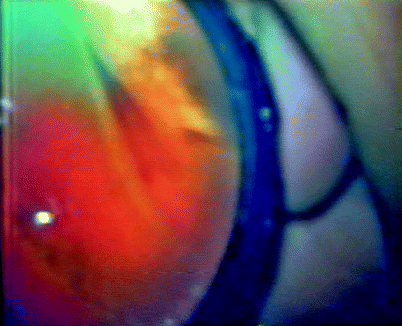
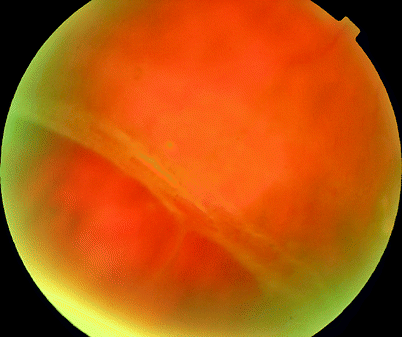

Fig. 7.1
A retinal dialysis is seen by indirect ophthalmoscopy and indentation

Fig. 7.2
A retinal dialysis
Clinical features in RRD from retinal dialysis
Sex | Males > females |
Age | 20–40 years |
Refraction | Emetropia |
Fellow eye at presentation | 8 % |
Onset | Slow |
Vitreous | Attached |
Retinal break type | Retinal dialysis |
Retinal break size | Large and medium |
Retinal break quadrant | Inferotemporal (superonasal more likely to be traumatic) |
Median number of breaks | 1 |
Multiple breaks >1 | 30 % |
Fovea off | 40 % |
PVR | Subretinal bands |
Surgery | Non-drain |
A separation of the vitreous base is sometimes seen as a ‘bucket handle’ in the inner surface of the dialysis, especially in traumatic cases. Blunt trauma has been associated with dialysis formation, but a history of trauma is not always present, and some are thought to be spontaneous (Kinyoun and Knobloch 1984). In the latter, a familial basis has been sought but remains uncertain (Verdaguer et al. 1975; Ross 1991). On rare occasions, a retinal dialysis is seen a few days after a severe contusion injury in which case the dialysis and retina are mobile.
The commonest sites are inferotemporal and superonasal. Fifty-six percent of inferotemporal dialyses have been associated with trauma and the 87 % of superonasal dialyses (Zion and Burton 1980). Fourteen percent are bilateral in which case the association with trauma is said to be less. Atopic dermatitis (Katsura and Hida 1984) and Down’s syndrome (Ahmad and Pruett 1976) have been associated with retinal dialysis.
The slow progression of retinal detachment means that most cases can be scheduled for surgery on a daytime list as opposed to emergency surgery, the exception being the case which appears immediately after trauma.
Occasionally, a very late presentation of retinal dialysis is associated with C grade PVR. These are very difficult to fix; see PVR.
7.5.2 Surgery for Retinal Dialysis
Table 7.1
Difficulty rating of surgery for retinal dialysis
Difficulty rating | Moderate |
Success rates | High |
Complication rates | Low |
When to use in training | Early |
The approach is the same as the non-drain procedure, but a few adaptations are required to cope with the particular characteristics of the dialysis. The operation can be technically demanding, but the results are potentially very good.
Search
Particular attention should be paid to the ora serrata over 360° because this is the position of any likely pathology. The indentation is very anterior as you are indenting the ora and therefore requires good control of the movement of the eye; use the muscle slings to fix the position of the eye (rest your fifth finger on the sling to stabilise the eye) during indentation. Carefully examine the ends of the dialysis for small extra dialysis. Very shallow dialysis will close when indented and can be missed. Move your indent in a circumferential direction around the ora so that the dialysis is partially opened on the edge of the indent to overcome this problem. I have seen U tears (surprisingly) accompanying the dialysis on rare occasion; therefore, the whole retina needs to be searched.
Cryotherapy
This requires confluence of the burns (see Sect. 7.5.2.4). Dialysis often extends from extraocular muscle insertion to extraocular muscle insertion (usually the inferior rectus to lateral rectus); therefore, the retinopexy is over a large area. The dialysis at its apex often seems too far away from the indent internally to achieve a cryotherapy burn. However, it is usually possible to obtain all the burns required. Be particularly aware of which parts of the retina you have treated (avoid overlapping the burns too much), to limit the number of burns but still achieve confluence. It is important that the retina has been sealed along all of the extent of the dialysis by the retinopexy because removal of the plombage postoperatively is sometimes required (to reverse complications from its anterior position, e.g. poor cosmesis or diplopia).
Marking the Break
For large dialysis, mark the ends, or the position of any satellite dialysis, and also the apex. The ends are usually at the muscle insertions, but it is important to know exactly where in case extension of the plombage under the muscle is required running the risk of postoperative diplopia (especially with the superior and inferior recti). The apex may extend further posteriorly than the ends of the dialysis requiring bowing of the plombage to ensure that the dialysis will fall onto the smallest plombage.
Plombage
Select a sponge that will cover the required area. A 4-mm sponge is preferred because it will be less prominent postoperatively than a 5 mm. However, the elevations of some dialyses are very high and may require the latter. If the dialysis is small, two sutures will be sufficient, which with a 4-mm sponge is unlikely to compromise the optic nerve circulation (check it after suture tying in any case). Larger dialyses require three sutures, one at each end and one at the apex. Insert the sutures as usual placing the ‘marks’ on the sclera centrally between the suture bites. Tie one of the sutures at one end of the plomb. Perform a paracentesis and remove approximately 0.15 ml of aqueous. This avoids occlusion of the optic nerve circulation. Tie the middle suture. The softer eye eases the production of a high indent at the apex. Finally, tie the last suture. Softening of the eye causes the plombage to produce an internal indent rather than being proud of the eye (resulting in poor cosmesis or disturbance the function of the extraocular muscles).
Checking the Indent
Check the optic nerve. View the indent, which should go past the ends of the dialysis slightly, and judge that the dialysis will fall on to the apex of the indent or slightly onto the anterior border (remember parallax). Trim the ends of the indent and slope the ends 45° to help reduce the protrusion of the sponge at its ends. Check that Tenon’s is not caught up in the sutures, and sew up the conjunctiva.
7.5.3 Complications
The complications are as for non-drain procedures; however, the anterior placement of the plombage, the need for a long circumferential plombage and the need to insert under vertical recti increase the chance of some complications.
Diplopia. Surgery around the vertical recti is more likely to induce diplopia because the vertical fusion range is less than the horizontal. If diplopia occurs, removing the plombage early will usually alleviate the problem.
Note: The plombage can be removed as soon as the retinopexy has sealed the break, for example, 10 days.
Cosmesis. The plombage may be visible because of the anterior placement and the inferotemporal position of many dialyses.
Note: Some surgeons because of the possibility of poor cosmesis use solid silicone explants but perform external drainage of SRF with its attendant risks.
Trapped foveal SRF occurs because of the chronicity of the RRD.
Failure of reattachment is rare if the indent is in the correct place; fish mouthing (folding of the break on a circumferential indent) does not seem to happen. I have seen a dialysis held off the indent by two retinal cysts. The patient was reoperated with removal of the original indent and a radial plomb placed on the unattached area of the break between the two cysts.
7.5.4 Giant Retinal Dialysis
This is a rare presentation in which the dialysis is more than 90°. The presentation in my experience has occurred in patients with an odd traumatic history such as patients who may injure their own eyes, for example, schizophrenia or patients who are under institutional care from neurological deficit (e.g. cerebral palsy). Non-drain surgery will not work in these, and a PPV will be required. The PHM will need to be detached from the retina, and the vitreous will be removed over the break to gain access to the SRF through the dialysis. Take care when you have instruments at the site of the break because you are very close to the lens which can be damaged. Apply laser retinopexy and minimal cryotherapy; use a long-acting gas or silicone oil.
7.5.5 Dialysis and PVR
Subretinal bands are the commonest form of PVR in dialysis. Mostly these will allow use of the non-drain procedure and settling of the RRD with minimal tenting of the retina. Occasionally, more severe PVR is seen in grade C. This is very difficult to deal with and is usually seen with an odd presentation such as severe trauma and delay in diagnosis (e.g. in a child). Apply PVR techniques to treat (Chap. 7).
7.5.6 Par Ciliaris Tear
This is a rare form of dialysis in which the tear is located in the pars plana. It occurs in severe blunt trauma and is usually seen in the superonasal quadrant. Consider the diagnosis in a child with a total shallow RRD of uncertain history (unfortunately, a common presentation in children) which is of unknown duration. These breaks are difficult to see and diagnose because of delay in presentation often accompanied with PVR. It is my only indication for an encircling explant, for example, 360° 7-mm wide solid silicone explant with an encircling band. If you can see the break, apply retinopexy. If not, use the explant on its own.
Surgical steps
360° conjunctival perimetry.
Sling all muscles.
Search.
Cryotherapy.
Place four 5/0 polyester sutures spaced at 9 mm apart, one in each quadrant straddling the ora serrata.
Insert the explant under the muscles and the sutures.
Method 1.
Insert the 2-mm silicone band starting superotemporally and returning there.
Insert one end of the silicone band through a silicone sleeve, for example, Watzke sleeve (place the sleeve on a curved artery clip and open the clip to expand the sleeve), then insert the other end of the band from the other direction. Close the forceps and slip off the sleeve.
Tighten the silicone band by pulling through about 1 cm.
Method 2.
Suture the two ends of the solid silicone explant together (insert the needle and suture directly into the explant) with a nonabsorbable suture.
Check you have a diffuse indent and the optic nerve is perfusing.
Close.
Note: These retinas are difficult to fix a decision to perform PPV, and oil must be taken very carefully. These eyes may have poor visual recovery, even if successful. They are cosmetically normal at presentation and relatively nonprogressive because of shallow RRD and formed vitreous; therefore, it may not be in your patient’s best interests to pursue multiple operations with attendant cosmetic changes to the eye. Often, these eyes are stable after surgery even with a persistent shallow total RRD and maintain some navigation vision. These young patients do not want the risk of an ugly phthisical eye from multiple operations.
7.6 Giant Retinal Tear
7.6.1 Clinical Features
A giant retinal tear (GRT) is defined as a tear of more than three clock hours of the retina (or 90°) with PVD with an incidence 0.091 per 100,000 in the UK (Ang et al. 2010). The patients are often in the third to fifth decades of age, more often male and present early, frequently with the macula still on (55 %) (Ang et al. 2010). The vitreous is detached from the posterior pole and is attached to the anterior portion of the retinal tear, thereby distinguishing a GRT from a dialysis. Because the posterior flap of the tear is not attached to the vitreous, this can fold over on itself onto the retina (Fig. 7.3). In addition, there may be radial slits at either end of the tear extending posteriorly, which also aid the folding of the retina. There may be satellite U-shaped breaks elsewhere in the retina that should be searched for (Fig. 7.4).
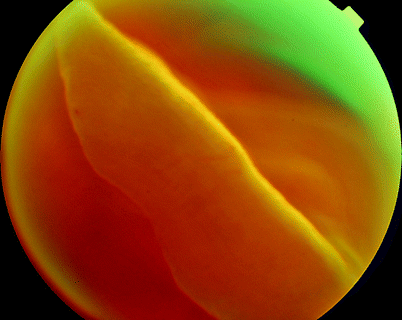
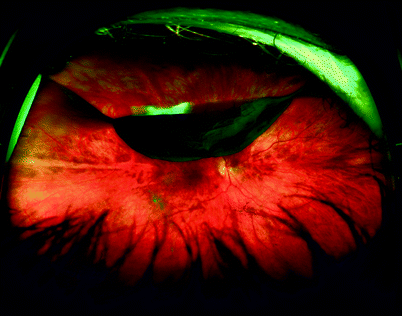

Fig. 7.3
Giant retinal tears can often fold over onto the posterior retina

Fig. 7.4
A wide angle view of a superior giant retinal tear
A giant retinal tear may occur in isolation, usually in a myopic patient, but may also be present in hereditary vitreoretinal disorders such as Stickler’s syndrome (14 %) (Billington et al. 1985) or rarely in Marfan’s syndrome (Sharma et al. 2002). In Sticker’s syndrome, in particular, there is a risk of bilateral retinal tears up to 40 %, and for this reason, some surgeons advocate prophylactic 360° cryotherapy to the fellow eye (Wolfensberger et al. 2003). A giant retinal tear can also occur as a result of trauma either penetrating or nonpenetrating (Duguid and Leaver 2000; Aylward et al. 1993). It possible for the tear to appear during complicated anterior segment surgery when traction on the vitreous pulls on the vitreous base (McLeod 1985; Aaberg et al. 1997). A careless vitreoretinal surgeon may induce a GRT during insertion of instruments through the vitreous base at the pars plana.
7.6.2 Stickler’s Syndrome
This syndrome is characterised by myopia, paravascular pigmentary changes and dragging of the major vessels at the optic disc, ‘veils’ or condensations of cortical vitreous around large lacunae or dehiscence’s in the gel and multiple posterior vitreoretinal adhesions. Differentiation from the Wagner syndrome is dubious. Stickler’s syndrome has an autosomal dominant inheritance and has highly variable penetrance. A possible genetic abnormality has been identified at COL2A1 (Richards et al. 2000, 2005; Snead and Yates 1999). Systemic associations are very variable and include high palate, characteristic facies with a flattened nasal bridge, short mandible and long philtre and arthralgia (Spallone 1987). Retinal detachments are related to posterior paravascular vitreoretinal adhesions or to radially orientated post-equatorial lattice degeneration. Bilateral giant retinal tears are common.
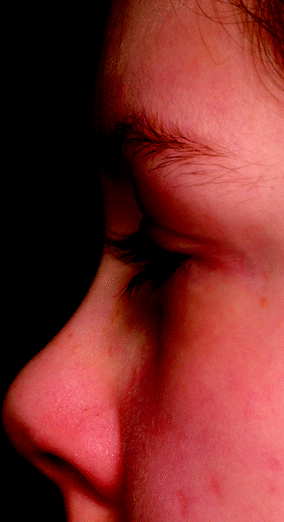
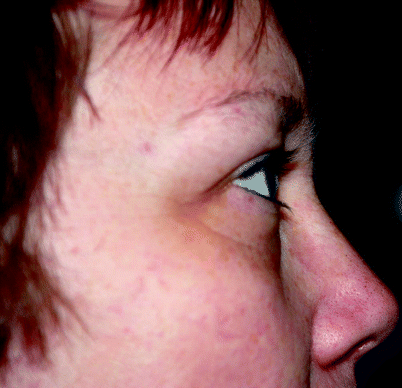
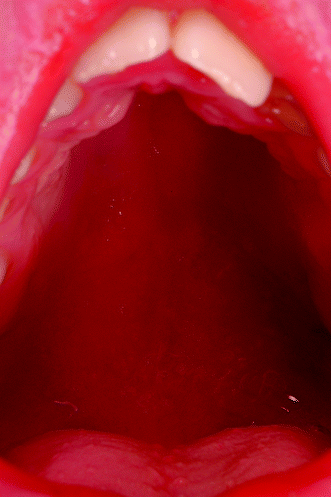
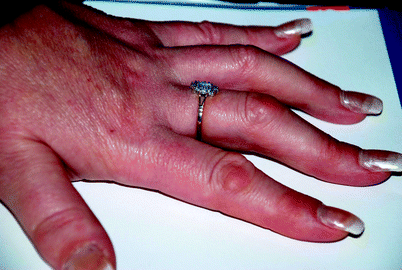
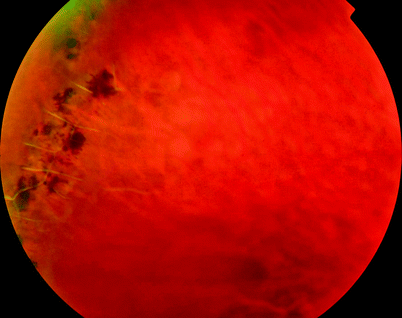
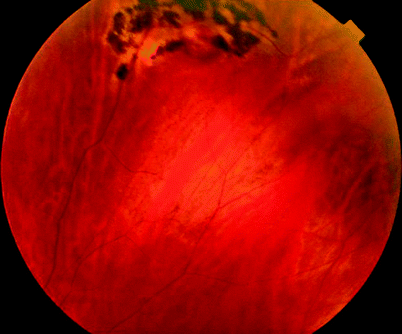
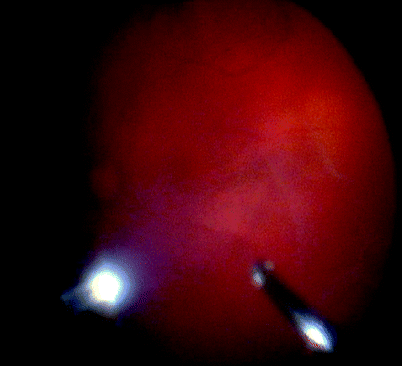
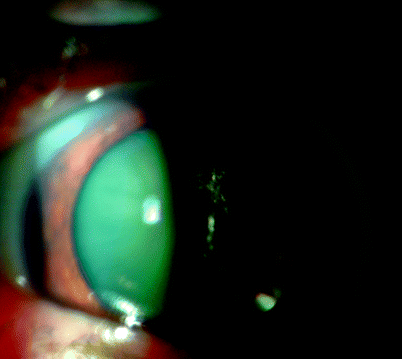
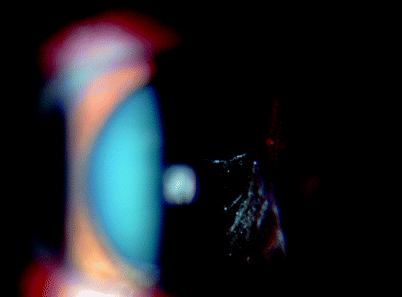
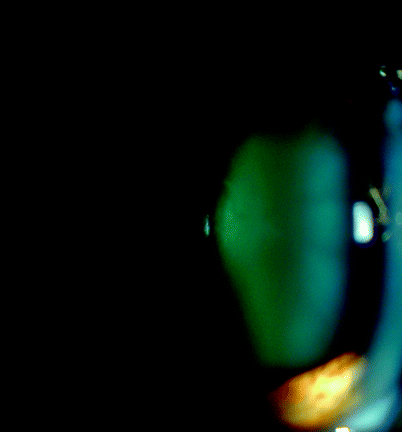
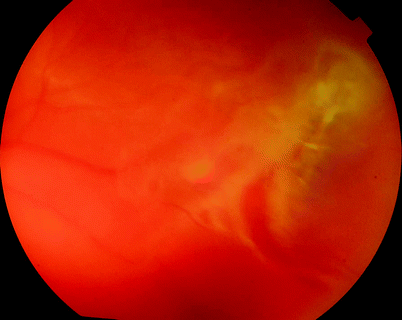
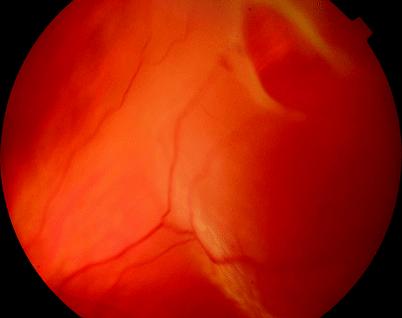

Fig. 7.5
The flattened nasal bridge typical of Stickler’s syndrome

Fig. 7.6
The flattened nasal bridge in Stickler’s syndrome

Fig. 7.7
A high-arched palate in Stickler’s syndrome

Fig. 7.8
Arthropathy in Stickler’s syndrome

Fig. 7.9
Lattice degeneration in a patient with Stickler’s syndrome

Fig. 7.10
Lattice is seen around a blood vessel typically in Stickler’s syndrome

Fig. 7.11
The vitreous in Stickler’s syndrome has veils of condensed vitreous within an otherwise optically empty vitreous cavity

Fig. 7.12
Vitreous veils are seen in these images from a father and son with Stickler’s syndrome (see Fig. 7.13)

Fig. 7.13
See previous figure

Fig. 7.14
Some vitreoretinal surgeons claim that there is a form of Stickler’s syndrome which does not have optically clear vitreous but has a membrane in the anterior vitreous as in this image

Fig. 7.15
A retinal tear near lattice in Stickler’s syndrome

Fig. 7.16
A retinal tear in Stickler’s syndrome
7.6.3 Surgery for Giant Retinal Tear
Table 7.2
Difficulty rating of PPV for GRT
Difficulty rating | Moderate |
Success rates | High |
Complication rates | Medium |
When to use in training | Middle |
Additional surgical steps
1.
Insert heavy liquids.
2.
Apply laser retinopexy under heavy liquid tamponade.
3.
Exchange silicone oil (air then gas if a small, 90–180°, superior GRT is present) for heavy liquid.
4.
Apply further retinopexy as required.
Vitrectomy has been used for many years for giant retinal tears (Vidaurri-Leal et al. 1984; Leaver et al. 1984; Peyman et al. 1984; Michels et al. 1983; Federman et al. 1982; Scott 1979), but recent innovations have considerably facilitated the manipulation of the retina.
Heavy Liquids
Insert heavy liquids (perfluorocarbon liquids) into the eye to unfold the flap of retina and to stabilise the retina (Kreiger and Lewis 1992; Glaser et al. 1991; Chang et al. 1989; Millsap et al. 1993; Mathis et al. 1992; Scott et al. 2002; Chang 1987). Advance the heavy liquid up to the posterior edge of the tear: Advancing over the tear risks allowing a droplet of heavy liquid to enter under the retina; however, if there is no traction on the edge of the tear, this is unlikely. Use of heavy liquid minimises the risk of slippage of the retina (to 7 % in one study (Meffert and Peyman 1999)). Search 360° in case there are satellite U tears that need treatment as well. If the giant retinal tear is relatively posterior, you may be able to flatten the retina with the heavy liquids and apply laser therapy under heavy liquids. This will provide slightly improved optical properties over trying to do this under the silicone oil. However, occasionally, the giant retinal tear is very anterior, and to fill the eye fully with heavy liquids runs the risk of leaving bubbles of heavy liquid at the vitreous base. These will be seen by the patient postoperatively when lying supine (the bubbles sink onto the fovea) and may enter the anterior chamber and be seen as droplets lying in the inferior angle.

